Evidence in Health and Social Care Practice
VerifiedAdded on 2023/06/11
|15
|4444
|423
AI Summary
This essay critically appraises a qualitative research article on the experience of anxiety among patients with severe COPD. The essay uses the CASP tool to evaluate the validity of the research and discusses the significance of the evidence in clinical practice.
Contribute Materials
Your contribution can guide someone’s learning journey. Share your
documents today.
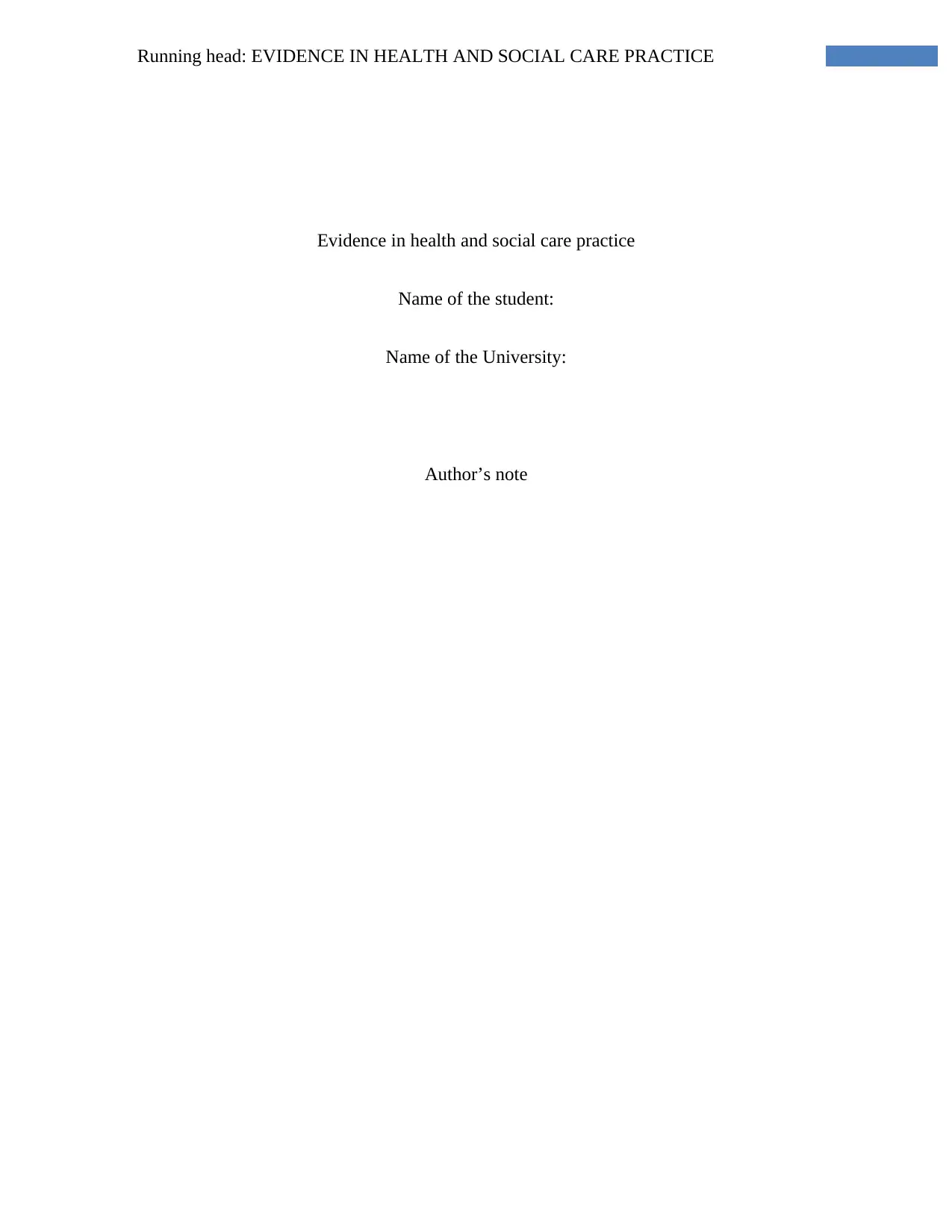
Running head: EVIDENCE IN HEALTH AND SOCIAL CARE PRACTICE
Evidence in health and social care practice
Name of the student:
Name of the University:
Author’s note
Evidence in health and social care practice
Name of the student:
Name of the University:
Author’s note
Secure Best Marks with AI Grader
Need help grading? Try our AI Grader for instant feedback on your assignments.
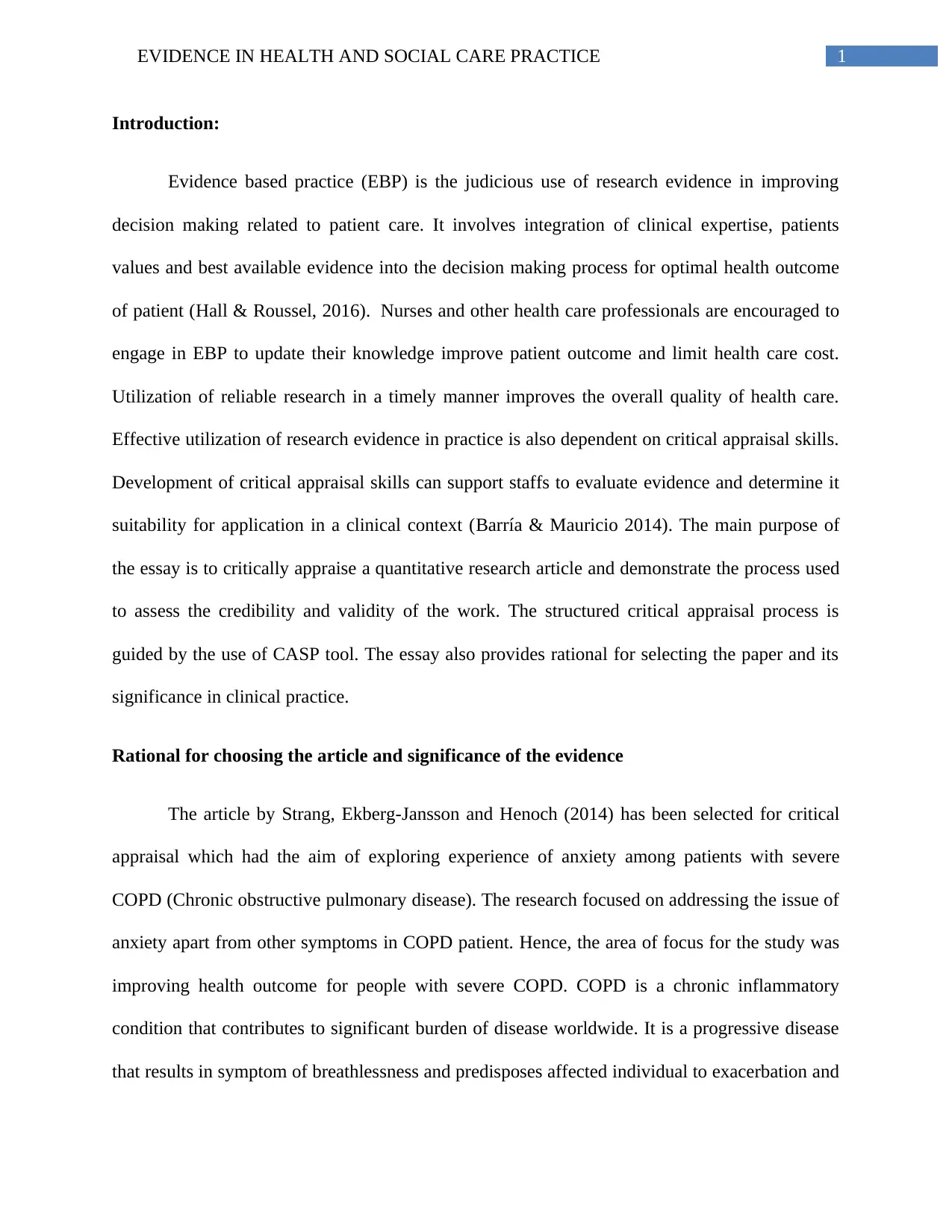
1EVIDENCE IN HEALTH AND SOCIAL CARE PRACTICE
Introduction:
Evidence based practice (EBP) is the judicious use of research evidence in improving
decision making related to patient care. It involves integration of clinical expertise, patients
values and best available evidence into the decision making process for optimal health outcome
of patient (Hall & Roussel, 2016). Nurses and other health care professionals are encouraged to
engage in EBP to update their knowledge improve patient outcome and limit health care cost.
Utilization of reliable research in a timely manner improves the overall quality of health care.
Effective utilization of research evidence in practice is also dependent on critical appraisal skills.
Development of critical appraisal skills can support staffs to evaluate evidence and determine it
suitability for application in a clinical context (Barría & Mauricio 2014). The main purpose of
the essay is to critically appraise a quantitative research article and demonstrate the process used
to assess the credibility and validity of the work. The structured critical appraisal process is
guided by the use of CASP tool. The essay also provides rational for selecting the paper and its
significance in clinical practice.
Rational for choosing the article and significance of the evidence
The article by Strang, Ekberg-Jansson and Henoch (2014) has been selected for critical
appraisal which had the aim of exploring experience of anxiety among patients with severe
COPD (Chronic obstructive pulmonary disease). The research focused on addressing the issue of
anxiety apart from other symptoms in COPD patient. Hence, the area of focus for the study was
improving health outcome for people with severe COPD. COPD is a chronic inflammatory
condition that contributes to significant burden of disease worldwide. It is a progressive disease
that results in symptom of breathlessness and predisposes affected individual to exacerbation and
Introduction:
Evidence based practice (EBP) is the judicious use of research evidence in improving
decision making related to patient care. It involves integration of clinical expertise, patients
values and best available evidence into the decision making process for optimal health outcome
of patient (Hall & Roussel, 2016). Nurses and other health care professionals are encouraged to
engage in EBP to update their knowledge improve patient outcome and limit health care cost.
Utilization of reliable research in a timely manner improves the overall quality of health care.
Effective utilization of research evidence in practice is also dependent on critical appraisal skills.
Development of critical appraisal skills can support staffs to evaluate evidence and determine it
suitability for application in a clinical context (Barría & Mauricio 2014). The main purpose of
the essay is to critically appraise a quantitative research article and demonstrate the process used
to assess the credibility and validity of the work. The structured critical appraisal process is
guided by the use of CASP tool. The essay also provides rational for selecting the paper and its
significance in clinical practice.
Rational for choosing the article and significance of the evidence
The article by Strang, Ekberg-Jansson and Henoch (2014) has been selected for critical
appraisal which had the aim of exploring experience of anxiety among patients with severe
COPD (Chronic obstructive pulmonary disease). The research focused on addressing the issue of
anxiety apart from other symptoms in COPD patient. Hence, the area of focus for the study was
improving health outcome for people with severe COPD. COPD is a chronic inflammatory
condition that contributes to significant burden of disease worldwide. It is a progressive disease
that results in symptom of breathlessness and predisposes affected individual to exacerbation and
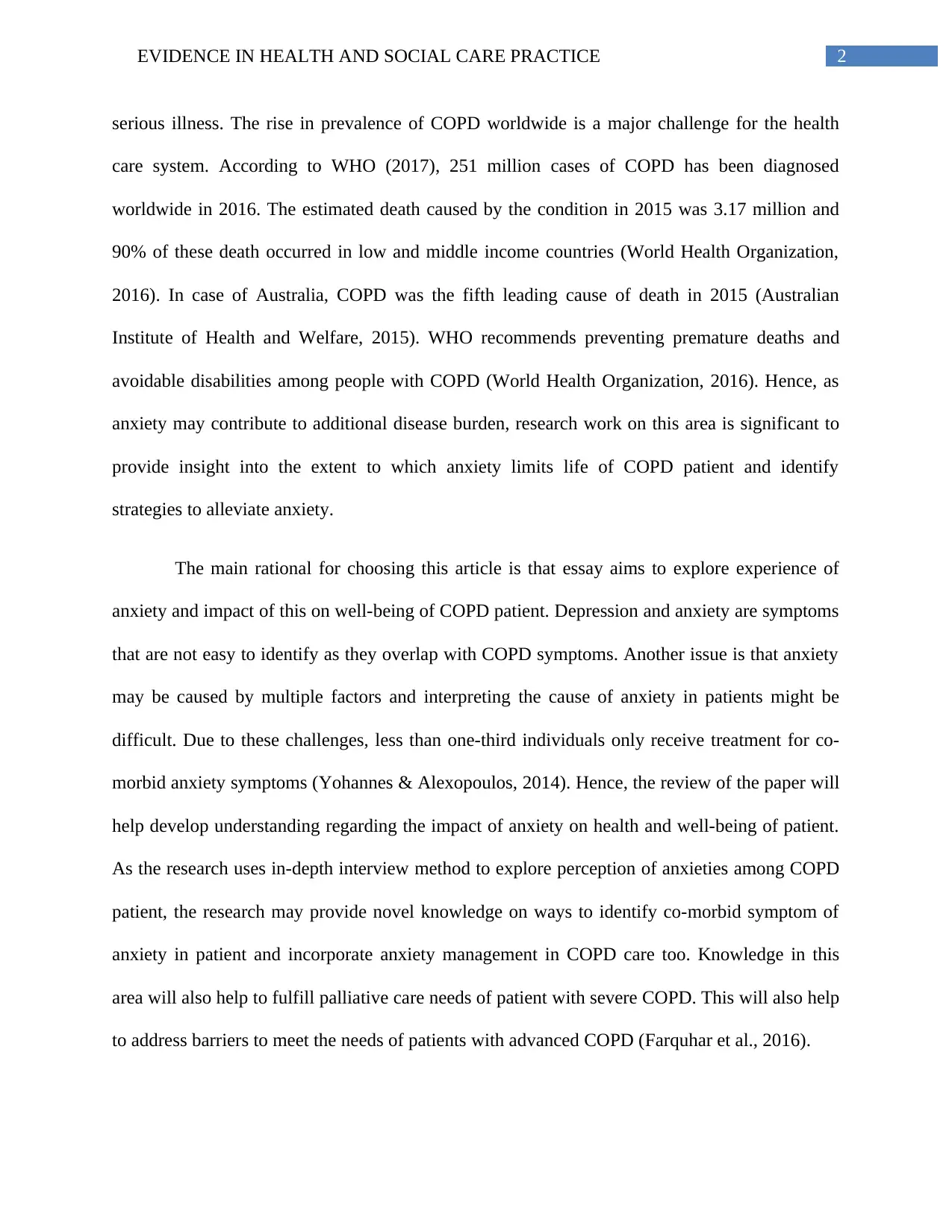
2EVIDENCE IN HEALTH AND SOCIAL CARE PRACTICE
serious illness. The rise in prevalence of COPD worldwide is a major challenge for the health
care system. According to WHO (2017), 251 million cases of COPD has been diagnosed
worldwide in 2016. The estimated death caused by the condition in 2015 was 3.17 million and
90% of these death occurred in low and middle income countries (World Health Organization,
2016). In case of Australia, COPD was the fifth leading cause of death in 2015 (Australian
Institute of Health and Welfare, 2015). WHO recommends preventing premature deaths and
avoidable disabilities among people with COPD (World Health Organization, 2016). Hence, as
anxiety may contribute to additional disease burden, research work on this area is significant to
provide insight into the extent to which anxiety limits life of COPD patient and identify
strategies to alleviate anxiety.
The main rational for choosing this article is that essay aims to explore experience of
anxiety and impact of this on well-being of COPD patient. Depression and anxiety are symptoms
that are not easy to identify as they overlap with COPD symptoms. Another issue is that anxiety
may be caused by multiple factors and interpreting the cause of anxiety in patients might be
difficult. Due to these challenges, less than one-third individuals only receive treatment for co-
morbid anxiety symptoms (Yohannes & Alexopoulos, 2014). Hence, the review of the paper will
help develop understanding regarding the impact of anxiety on health and well-being of patient.
As the research uses in-depth interview method to explore perception of anxieties among COPD
patient, the research may provide novel knowledge on ways to identify co-morbid symptom of
anxiety in patient and incorporate anxiety management in COPD care too. Knowledge in this
area will also help to fulfill palliative care needs of patient with severe COPD. This will also help
to address barriers to meet the needs of patients with advanced COPD (Farquhar et al., 2016).
serious illness. The rise in prevalence of COPD worldwide is a major challenge for the health
care system. According to WHO (2017), 251 million cases of COPD has been diagnosed
worldwide in 2016. The estimated death caused by the condition in 2015 was 3.17 million and
90% of these death occurred in low and middle income countries (World Health Organization,
2016). In case of Australia, COPD was the fifth leading cause of death in 2015 (Australian
Institute of Health and Welfare, 2015). WHO recommends preventing premature deaths and
avoidable disabilities among people with COPD (World Health Organization, 2016). Hence, as
anxiety may contribute to additional disease burden, research work on this area is significant to
provide insight into the extent to which anxiety limits life of COPD patient and identify
strategies to alleviate anxiety.
The main rational for choosing this article is that essay aims to explore experience of
anxiety and impact of this on well-being of COPD patient. Depression and anxiety are symptoms
that are not easy to identify as they overlap with COPD symptoms. Another issue is that anxiety
may be caused by multiple factors and interpreting the cause of anxiety in patients might be
difficult. Due to these challenges, less than one-third individuals only receive treatment for co-
morbid anxiety symptoms (Yohannes & Alexopoulos, 2014). Hence, the review of the paper will
help develop understanding regarding the impact of anxiety on health and well-being of patient.
As the research uses in-depth interview method to explore perception of anxieties among COPD
patient, the research may provide novel knowledge on ways to identify co-morbid symptom of
anxiety in patient and incorporate anxiety management in COPD care too. Knowledge in this
area will also help to fulfill palliative care needs of patient with severe COPD. This will also help
to address barriers to meet the needs of patients with advanced COPD (Farquhar et al., 2016).
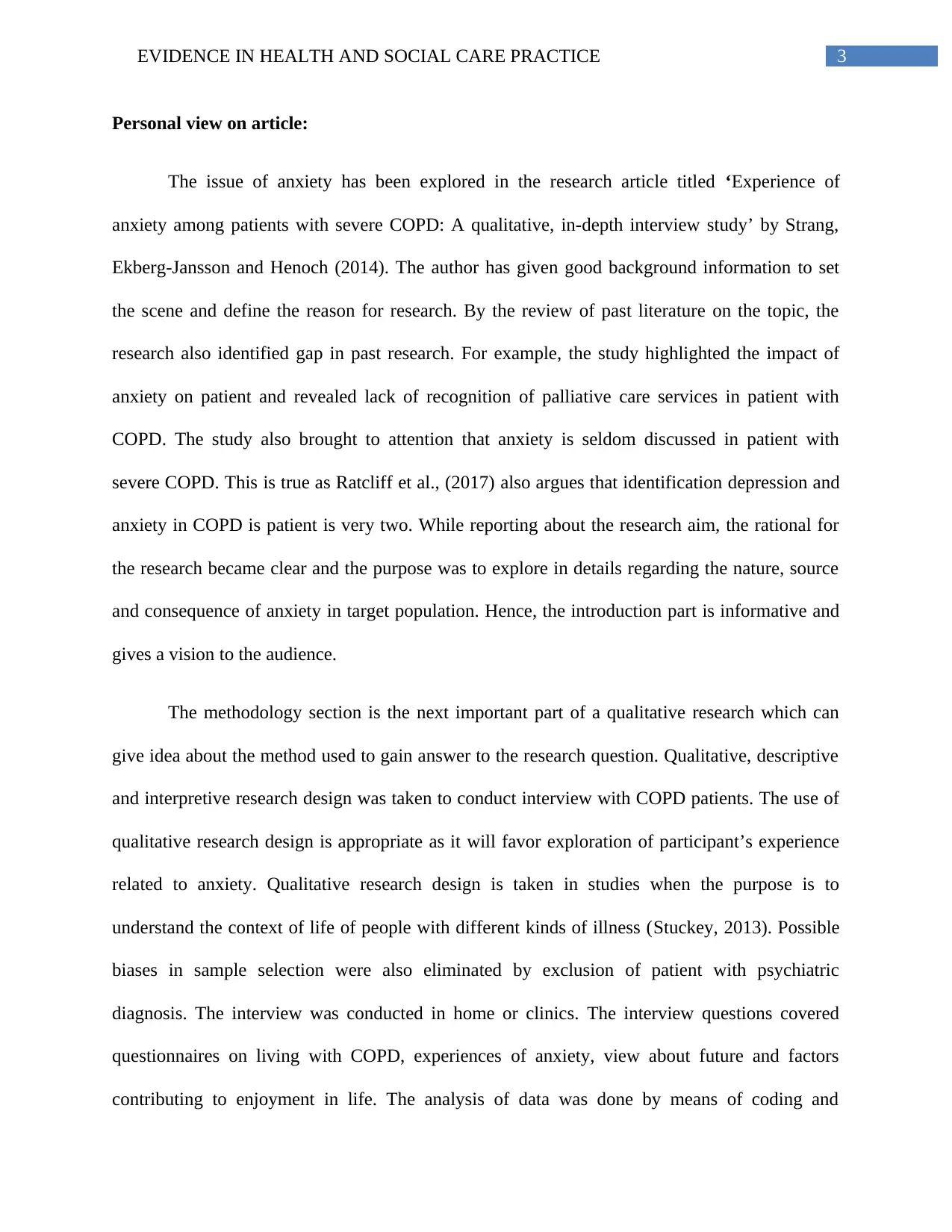
3EVIDENCE IN HEALTH AND SOCIAL CARE PRACTICE
Personal view on article:
The issue of anxiety has been explored in the research article titled ‘Experience of
anxiety among patients with severe COPD: A qualitative, in-depth interview study’ by Strang,
Ekberg-Jansson and Henoch (2014). The author has given good background information to set
the scene and define the reason for research. By the review of past literature on the topic, the
research also identified gap in past research. For example, the study highlighted the impact of
anxiety on patient and revealed lack of recognition of palliative care services in patient with
COPD. The study also brought to attention that anxiety is seldom discussed in patient with
severe COPD. This is true as Ratcliff et al., (2017) also argues that identification depression and
anxiety in COPD is patient is very two. While reporting about the research aim, the rational for
the research became clear and the purpose was to explore in details regarding the nature, source
and consequence of anxiety in target population. Hence, the introduction part is informative and
gives a vision to the audience.
The methodology section is the next important part of a qualitative research which can
give idea about the method used to gain answer to the research question. Qualitative, descriptive
and interpretive research design was taken to conduct interview with COPD patients. The use of
qualitative research design is appropriate as it will favor exploration of participant’s experience
related to anxiety. Qualitative research design is taken in studies when the purpose is to
understand the context of life of people with different kinds of illness (Stuckey, 2013). Possible
biases in sample selection were also eliminated by exclusion of patient with psychiatric
diagnosis. The interview was conducted in home or clinics. The interview questions covered
questionnaires on living with COPD, experiences of anxiety, view about future and factors
contributing to enjoyment in life. The analysis of data was done by means of coding and
Personal view on article:
The issue of anxiety has been explored in the research article titled ‘Experience of
anxiety among patients with severe COPD: A qualitative, in-depth interview study’ by Strang,
Ekberg-Jansson and Henoch (2014). The author has given good background information to set
the scene and define the reason for research. By the review of past literature on the topic, the
research also identified gap in past research. For example, the study highlighted the impact of
anxiety on patient and revealed lack of recognition of palliative care services in patient with
COPD. The study also brought to attention that anxiety is seldom discussed in patient with
severe COPD. This is true as Ratcliff et al., (2017) also argues that identification depression and
anxiety in COPD is patient is very two. While reporting about the research aim, the rational for
the research became clear and the purpose was to explore in details regarding the nature, source
and consequence of anxiety in target population. Hence, the introduction part is informative and
gives a vision to the audience.
The methodology section is the next important part of a qualitative research which can
give idea about the method used to gain answer to the research question. Qualitative, descriptive
and interpretive research design was taken to conduct interview with COPD patients. The use of
qualitative research design is appropriate as it will favor exploration of participant’s experience
related to anxiety. Qualitative research design is taken in studies when the purpose is to
understand the context of life of people with different kinds of illness (Stuckey, 2013). Possible
biases in sample selection were also eliminated by exclusion of patient with psychiatric
diagnosis. The interview was conducted in home or clinics. The interview questions covered
questionnaires on living with COPD, experiences of anxiety, view about future and factors
contributing to enjoyment in life. The analysis of data was done by means of coding and
Secure Best Marks with AI Grader
Need help grading? Try our AI Grader for instant feedback on your assignments.
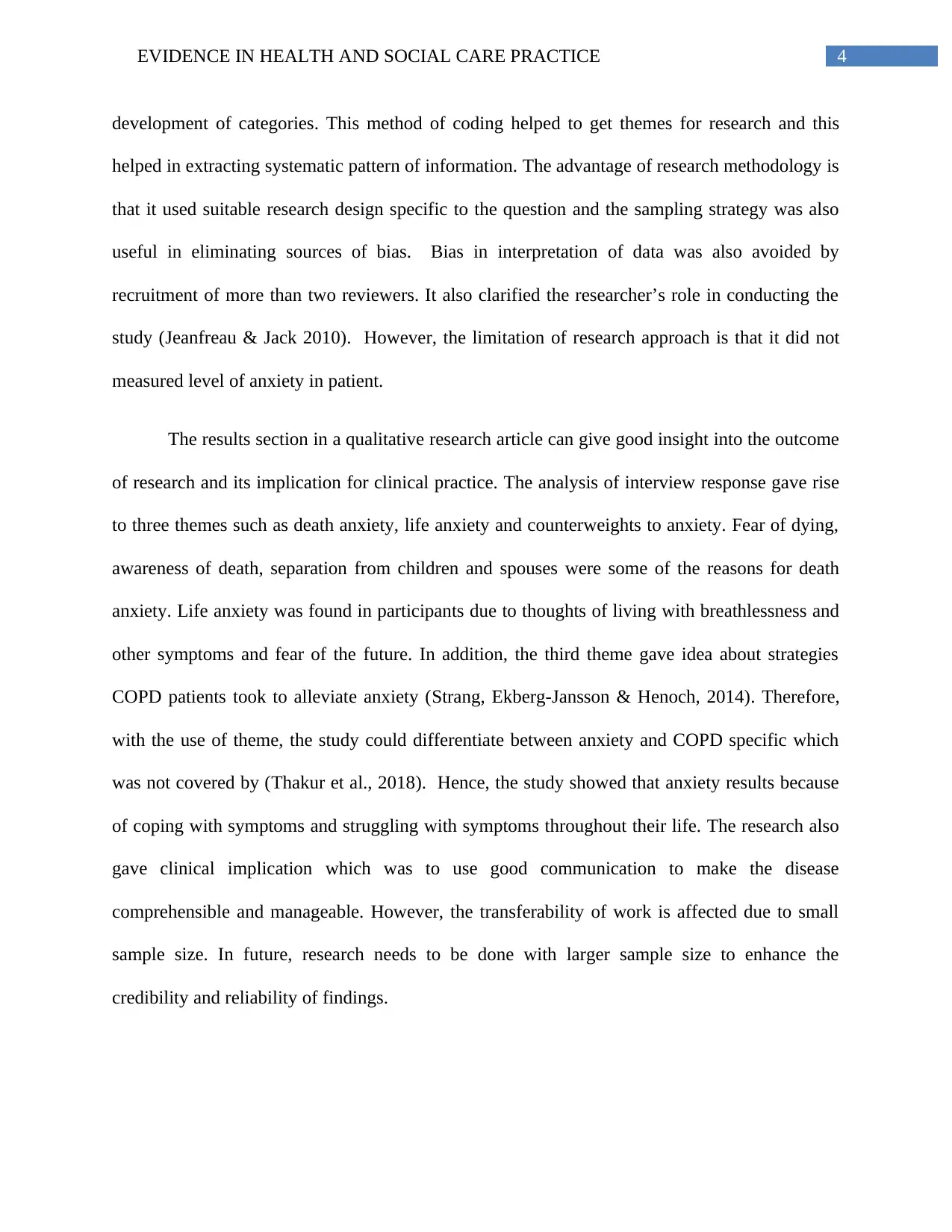
4EVIDENCE IN HEALTH AND SOCIAL CARE PRACTICE
development of categories. This method of coding helped to get themes for research and this
helped in extracting systematic pattern of information. The advantage of research methodology is
that it used suitable research design specific to the question and the sampling strategy was also
useful in eliminating sources of bias. Bias in interpretation of data was also avoided by
recruitment of more than two reviewers. It also clarified the researcher’s role in conducting the
study (Jeanfreau & Jack 2010). However, the limitation of research approach is that it did not
measured level of anxiety in patient.
The results section in a qualitative research article can give good insight into the outcome
of research and its implication for clinical practice. The analysis of interview response gave rise
to three themes such as death anxiety, life anxiety and counterweights to anxiety. Fear of dying,
awareness of death, separation from children and spouses were some of the reasons for death
anxiety. Life anxiety was found in participants due to thoughts of living with breathlessness and
other symptoms and fear of the future. In addition, the third theme gave idea about strategies
COPD patients took to alleviate anxiety (Strang, Ekberg-Jansson & Henoch, 2014). Therefore,
with the use of theme, the study could differentiate between anxiety and COPD specific which
was not covered by (Thakur et al., 2018). Hence, the study showed that anxiety results because
of coping with symptoms and struggling with symptoms throughout their life. The research also
gave clinical implication which was to use good communication to make the disease
comprehensible and manageable. However, the transferability of work is affected due to small
sample size. In future, research needs to be done with larger sample size to enhance the
credibility and reliability of findings.
development of categories. This method of coding helped to get themes for research and this
helped in extracting systematic pattern of information. The advantage of research methodology is
that it used suitable research design specific to the question and the sampling strategy was also
useful in eliminating sources of bias. Bias in interpretation of data was also avoided by
recruitment of more than two reviewers. It also clarified the researcher’s role in conducting the
study (Jeanfreau & Jack 2010). However, the limitation of research approach is that it did not
measured level of anxiety in patient.
The results section in a qualitative research article can give good insight into the outcome
of research and its implication for clinical practice. The analysis of interview response gave rise
to three themes such as death anxiety, life anxiety and counterweights to anxiety. Fear of dying,
awareness of death, separation from children and spouses were some of the reasons for death
anxiety. Life anxiety was found in participants due to thoughts of living with breathlessness and
other symptoms and fear of the future. In addition, the third theme gave idea about strategies
COPD patients took to alleviate anxiety (Strang, Ekberg-Jansson & Henoch, 2014). Therefore,
with the use of theme, the study could differentiate between anxiety and COPD specific which
was not covered by (Thakur et al., 2018). Hence, the study showed that anxiety results because
of coping with symptoms and struggling with symptoms throughout their life. The research also
gave clinical implication which was to use good communication to make the disease
comprehensible and manageable. However, the transferability of work is affected due to small
sample size. In future, research needs to be done with larger sample size to enhance the
credibility and reliability of findings.
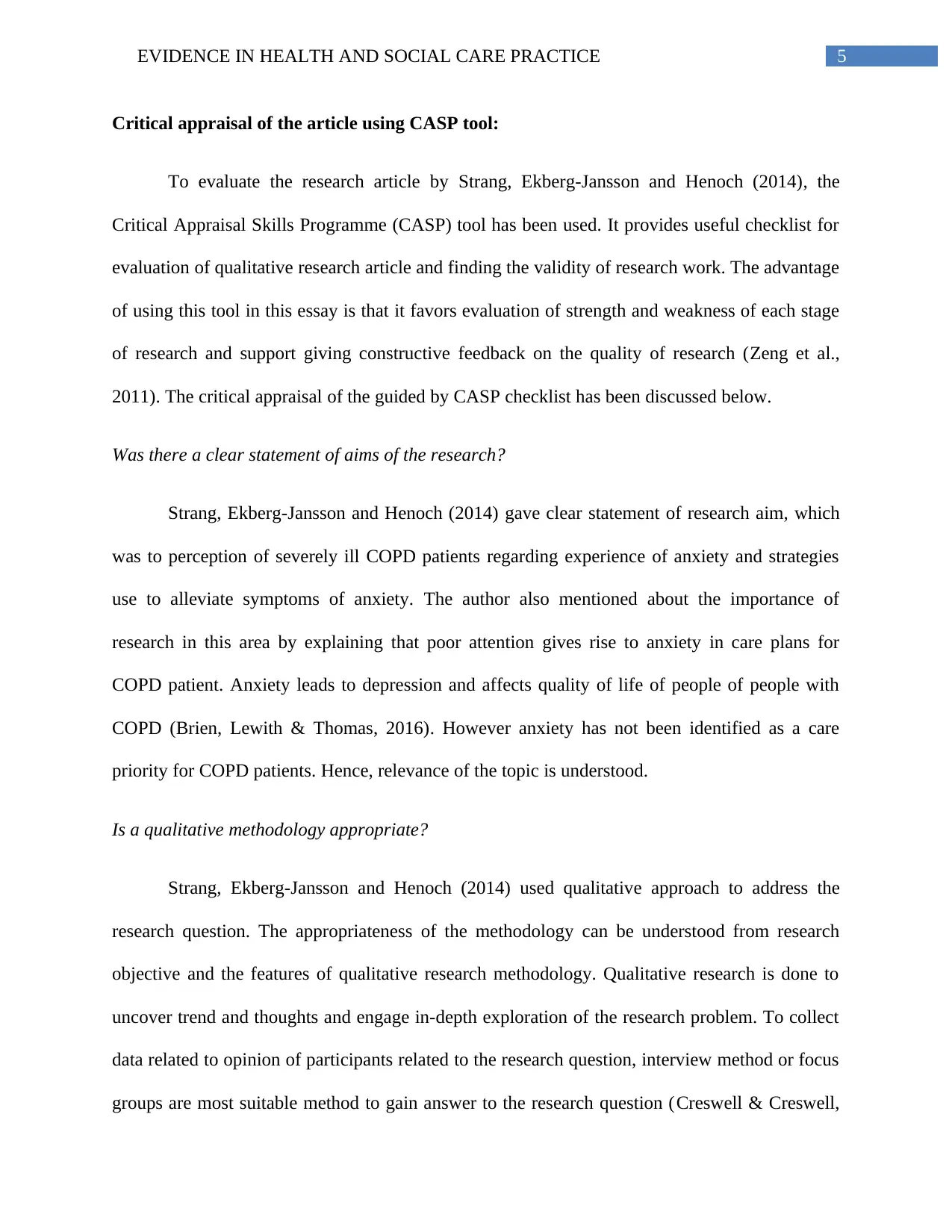
5EVIDENCE IN HEALTH AND SOCIAL CARE PRACTICE
Critical appraisal of the article using CASP tool:
To evaluate the research article by Strang, Ekberg-Jansson and Henoch (2014), the
Critical Appraisal Skills Programme (CASP) tool has been used. It provides useful checklist for
evaluation of qualitative research article and finding the validity of research work. The advantage
of using this tool in this essay is that it favors evaluation of strength and weakness of each stage
of research and support giving constructive feedback on the quality of research (Zeng et al.,
2011). The critical appraisal of the guided by CASP checklist has been discussed below.
Was there a clear statement of aims of the research?
Strang, Ekberg-Jansson and Henoch (2014) gave clear statement of research aim, which
was to perception of severely ill COPD patients regarding experience of anxiety and strategies
use to alleviate symptoms of anxiety. The author also mentioned about the importance of
research in this area by explaining that poor attention gives rise to anxiety in care plans for
COPD patient. Anxiety leads to depression and affects quality of life of people of people with
COPD (Brien, Lewith & Thomas, 2016). However anxiety has not been identified as a care
priority for COPD patients. Hence, relevance of the topic is understood.
Is a qualitative methodology appropriate?
Strang, Ekberg-Jansson and Henoch (2014) used qualitative approach to address the
research question. The appropriateness of the methodology can be understood from research
objective and the features of qualitative research methodology. Qualitative research is done to
uncover trend and thoughts and engage in-depth exploration of the research problem. To collect
data related to opinion of participants related to the research question, interview method or focus
groups are most suitable method to gain answer to the research question (Creswell & Creswell,
Critical appraisal of the article using CASP tool:
To evaluate the research article by Strang, Ekberg-Jansson and Henoch (2014), the
Critical Appraisal Skills Programme (CASP) tool has been used. It provides useful checklist for
evaluation of qualitative research article and finding the validity of research work. The advantage
of using this tool in this essay is that it favors evaluation of strength and weakness of each stage
of research and support giving constructive feedback on the quality of research (Zeng et al.,
2011). The critical appraisal of the guided by CASP checklist has been discussed below.
Was there a clear statement of aims of the research?
Strang, Ekberg-Jansson and Henoch (2014) gave clear statement of research aim, which
was to perception of severely ill COPD patients regarding experience of anxiety and strategies
use to alleviate symptoms of anxiety. The author also mentioned about the importance of
research in this area by explaining that poor attention gives rise to anxiety in care plans for
COPD patient. Anxiety leads to depression and affects quality of life of people of people with
COPD (Brien, Lewith & Thomas, 2016). However anxiety has not been identified as a care
priority for COPD patients. Hence, relevance of the topic is understood.
Is a qualitative methodology appropriate?
Strang, Ekberg-Jansson and Henoch (2014) used qualitative approach to address the
research question. The appropriateness of the methodology can be understood from research
objective and the features of qualitative research methodology. Qualitative research is done to
uncover trend and thoughts and engage in-depth exploration of the research problem. To collect
data related to opinion of participants related to the research question, interview method or focus
groups are most suitable method to gain answer to the research question (Creswell & Creswell,
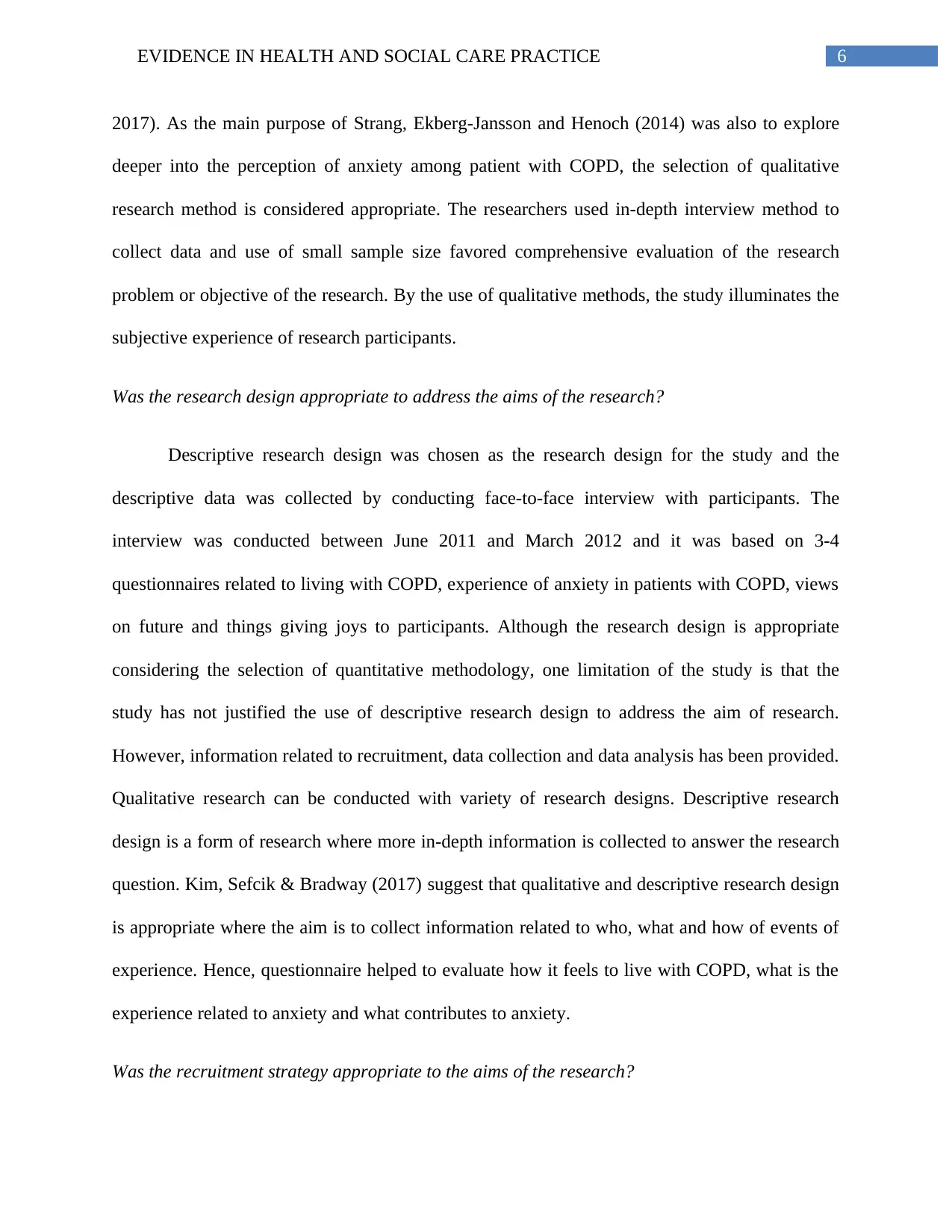
6EVIDENCE IN HEALTH AND SOCIAL CARE PRACTICE
2017). As the main purpose of Strang, Ekberg-Jansson and Henoch (2014) was also to explore
deeper into the perception of anxiety among patient with COPD, the selection of qualitative
research method is considered appropriate. The researchers used in-depth interview method to
collect data and use of small sample size favored comprehensive evaluation of the research
problem or objective of the research. By the use of qualitative methods, the study illuminates the
subjective experience of research participants.
Was the research design appropriate to address the aims of the research?
Descriptive research design was chosen as the research design for the study and the
descriptive data was collected by conducting face-to-face interview with participants. The
interview was conducted between June 2011 and March 2012 and it was based on 3-4
questionnaires related to living with COPD, experience of anxiety in patients with COPD, views
on future and things giving joys to participants. Although the research design is appropriate
considering the selection of quantitative methodology, one limitation of the study is that the
study has not justified the use of descriptive research design to address the aim of research.
However, information related to recruitment, data collection and data analysis has been provided.
Qualitative research can be conducted with variety of research designs. Descriptive research
design is a form of research where more in-depth information is collected to answer the research
question. Kim, Sefcik & Bradway (2017) suggest that qualitative and descriptive research design
is appropriate where the aim is to collect information related to who, what and how of events of
experience. Hence, questionnaire helped to evaluate how it feels to live with COPD, what is the
experience related to anxiety and what contributes to anxiety.
Was the recruitment strategy appropriate to the aims of the research?
2017). As the main purpose of Strang, Ekberg-Jansson and Henoch (2014) was also to explore
deeper into the perception of anxiety among patient with COPD, the selection of qualitative
research method is considered appropriate. The researchers used in-depth interview method to
collect data and use of small sample size favored comprehensive evaluation of the research
problem or objective of the research. By the use of qualitative methods, the study illuminates the
subjective experience of research participants.
Was the research design appropriate to address the aims of the research?
Descriptive research design was chosen as the research design for the study and the
descriptive data was collected by conducting face-to-face interview with participants. The
interview was conducted between June 2011 and March 2012 and it was based on 3-4
questionnaires related to living with COPD, experience of anxiety in patients with COPD, views
on future and things giving joys to participants. Although the research design is appropriate
considering the selection of quantitative methodology, one limitation of the study is that the
study has not justified the use of descriptive research design to address the aim of research.
However, information related to recruitment, data collection and data analysis has been provided.
Qualitative research can be conducted with variety of research designs. Descriptive research
design is a form of research where more in-depth information is collected to answer the research
question. Kim, Sefcik & Bradway (2017) suggest that qualitative and descriptive research design
is appropriate where the aim is to collect information related to who, what and how of events of
experience. Hence, questionnaire helped to evaluate how it feels to live with COPD, what is the
experience related to anxiety and what contributes to anxiety.
Was the recruitment strategy appropriate to the aims of the research?
Paraphrase This Document
Need a fresh take? Get an instant paraphrase of this document with our AI Paraphraser
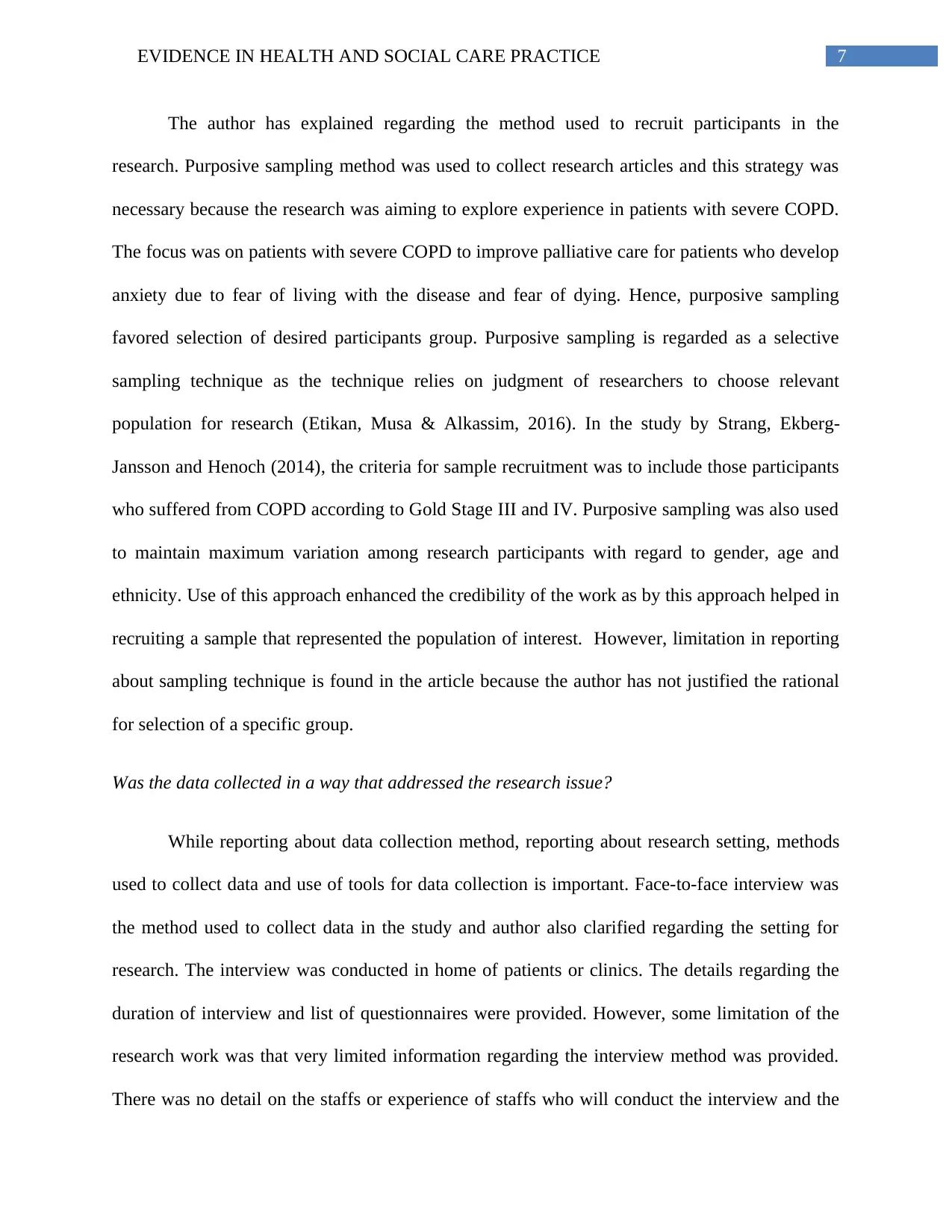
7EVIDENCE IN HEALTH AND SOCIAL CARE PRACTICE
The author has explained regarding the method used to recruit participants in the
research. Purposive sampling method was used to collect research articles and this strategy was
necessary because the research was aiming to explore experience in patients with severe COPD.
The focus was on patients with severe COPD to improve palliative care for patients who develop
anxiety due to fear of living with the disease and fear of dying. Hence, purposive sampling
favored selection of desired participants group. Purposive sampling is regarded as a selective
sampling technique as the technique relies on judgment of researchers to choose relevant
population for research (Etikan, Musa & Alkassim, 2016). In the study by Strang, Ekberg-
Jansson and Henoch (2014), the criteria for sample recruitment was to include those participants
who suffered from COPD according to Gold Stage III and IV. Purposive sampling was also used
to maintain maximum variation among research participants with regard to gender, age and
ethnicity. Use of this approach enhanced the credibility of the work as by this approach helped in
recruiting a sample that represented the population of interest. However, limitation in reporting
about sampling technique is found in the article because the author has not justified the rational
for selection of a specific group.
Was the data collected in a way that addressed the research issue?
While reporting about data collection method, reporting about research setting, methods
used to collect data and use of tools for data collection is important. Face-to-face interview was
the method used to collect data in the study and author also clarified regarding the setting for
research. The interview was conducted in home of patients or clinics. The details regarding the
duration of interview and list of questionnaires were provided. However, some limitation of the
research work was that very limited information regarding the interview method was provided.
There was no detail on the staffs or experience of staffs who will conduct the interview and the
The author has explained regarding the method used to recruit participants in the
research. Purposive sampling method was used to collect research articles and this strategy was
necessary because the research was aiming to explore experience in patients with severe COPD.
The focus was on patients with severe COPD to improve palliative care for patients who develop
anxiety due to fear of living with the disease and fear of dying. Hence, purposive sampling
favored selection of desired participants group. Purposive sampling is regarded as a selective
sampling technique as the technique relies on judgment of researchers to choose relevant
population for research (Etikan, Musa & Alkassim, 2016). In the study by Strang, Ekberg-
Jansson and Henoch (2014), the criteria for sample recruitment was to include those participants
who suffered from COPD according to Gold Stage III and IV. Purposive sampling was also used
to maintain maximum variation among research participants with regard to gender, age and
ethnicity. Use of this approach enhanced the credibility of the work as by this approach helped in
recruiting a sample that represented the population of interest. However, limitation in reporting
about sampling technique is found in the article because the author has not justified the rational
for selection of a specific group.
Was the data collected in a way that addressed the research issue?
While reporting about data collection method, reporting about research setting, methods
used to collect data and use of tools for data collection is important. Face-to-face interview was
the method used to collect data in the study and author also clarified regarding the setting for
research. The interview was conducted in home of patients or clinics. The details regarding the
duration of interview and list of questionnaires were provided. However, some limitation of the
research work was that very limited information regarding the interview method was provided.
There was no detail on the staffs or experience of staffs who will conduct the interview and the
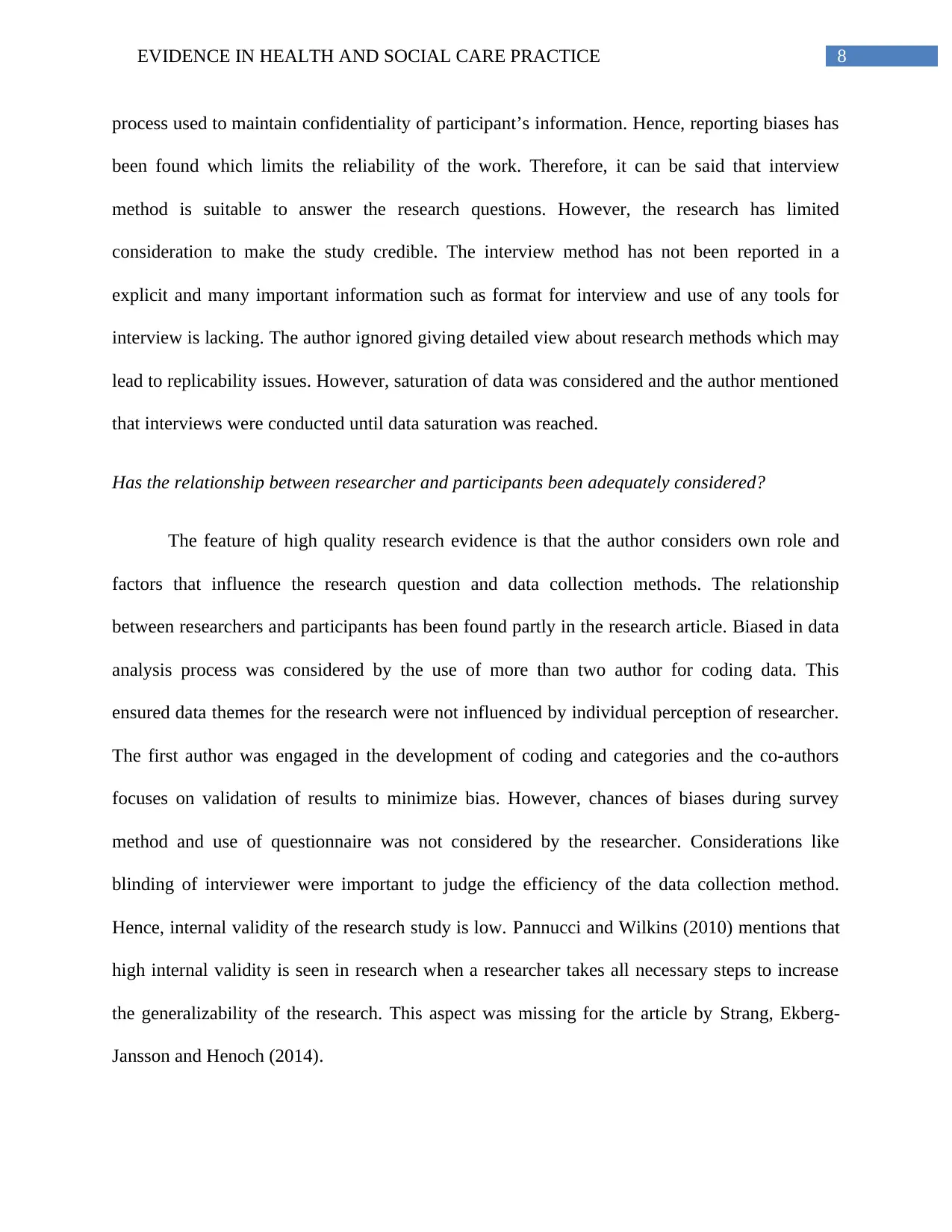
8EVIDENCE IN HEALTH AND SOCIAL CARE PRACTICE
process used to maintain confidentiality of participant’s information. Hence, reporting biases has
been found which limits the reliability of the work. Therefore, it can be said that interview
method is suitable to answer the research questions. However, the research has limited
consideration to make the study credible. The interview method has not been reported in a
explicit and many important information such as format for interview and use of any tools for
interview is lacking. The author ignored giving detailed view about research methods which may
lead to replicability issues. However, saturation of data was considered and the author mentioned
that interviews were conducted until data saturation was reached.
Has the relationship between researcher and participants been adequately considered?
The feature of high quality research evidence is that the author considers own role and
factors that influence the research question and data collection methods. The relationship
between researchers and participants has been found partly in the research article. Biased in data
analysis process was considered by the use of more than two author for coding data. This
ensured data themes for the research were not influenced by individual perception of researcher.
The first author was engaged in the development of coding and categories and the co-authors
focuses on validation of results to minimize bias. However, chances of biases during survey
method and use of questionnaire was not considered by the researcher. Considerations like
blinding of interviewer were important to judge the efficiency of the data collection method.
Hence, internal validity of the research study is low. Pannucci and Wilkins (2010) mentions that
high internal validity is seen in research when a researcher takes all necessary steps to increase
the generalizability of the research. This aspect was missing for the article by Strang, Ekberg-
Jansson and Henoch (2014).
process used to maintain confidentiality of participant’s information. Hence, reporting biases has
been found which limits the reliability of the work. Therefore, it can be said that interview
method is suitable to answer the research questions. However, the research has limited
consideration to make the study credible. The interview method has not been reported in a
explicit and many important information such as format for interview and use of any tools for
interview is lacking. The author ignored giving detailed view about research methods which may
lead to replicability issues. However, saturation of data was considered and the author mentioned
that interviews were conducted until data saturation was reached.
Has the relationship between researcher and participants been adequately considered?
The feature of high quality research evidence is that the author considers own role and
factors that influence the research question and data collection methods. The relationship
between researchers and participants has been found partly in the research article. Biased in data
analysis process was considered by the use of more than two author for coding data. This
ensured data themes for the research were not influenced by individual perception of researcher.
The first author was engaged in the development of coding and categories and the co-authors
focuses on validation of results to minimize bias. However, chances of biases during survey
method and use of questionnaire was not considered by the researcher. Considerations like
blinding of interviewer were important to judge the efficiency of the data collection method.
Hence, internal validity of the research study is low. Pannucci and Wilkins (2010) mentions that
high internal validity is seen in research when a researcher takes all necessary steps to increase
the generalizability of the research. This aspect was missing for the article by Strang, Ekberg-
Jansson and Henoch (2014).
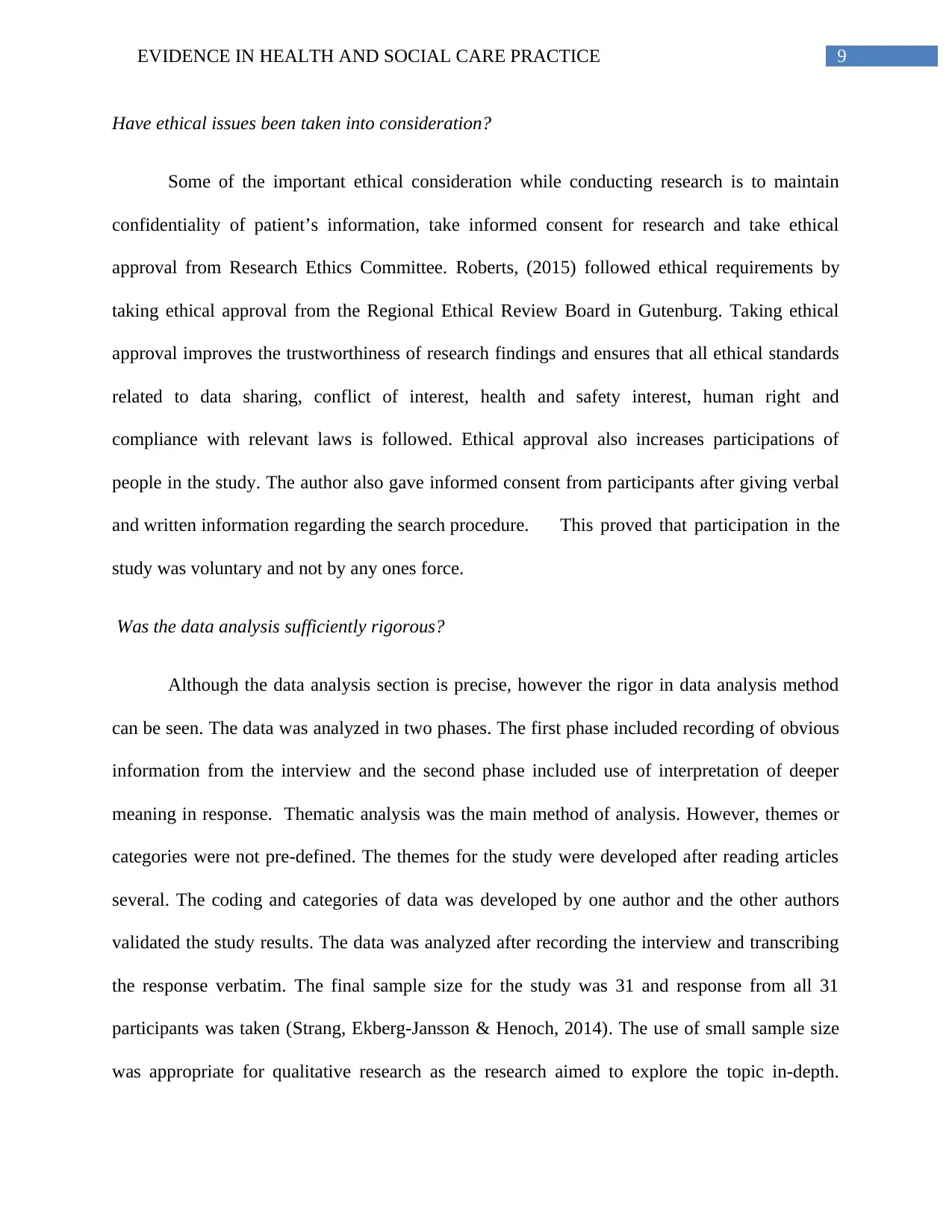
9EVIDENCE IN HEALTH AND SOCIAL CARE PRACTICE
Have ethical issues been taken into consideration?
Some of the important ethical consideration while conducting research is to maintain
confidentiality of patient’s information, take informed consent for research and take ethical
approval from Research Ethics Committee. Roberts, (2015) followed ethical requirements by
taking ethical approval from the Regional Ethical Review Board in Gutenburg. Taking ethical
approval improves the trustworthiness of research findings and ensures that all ethical standards
related to data sharing, conflict of interest, health and safety interest, human right and
compliance with relevant laws is followed. Ethical approval also increases participations of
people in the study. The author also gave informed consent from participants after giving verbal
and written information regarding the search procedure. This proved that participation in the
study was voluntary and not by any ones force.
Was the data analysis sufficiently rigorous?
Although the data analysis section is precise, however the rigor in data analysis method
can be seen. The data was analyzed in two phases. The first phase included recording of obvious
information from the interview and the second phase included use of interpretation of deeper
meaning in response. Thematic analysis was the main method of analysis. However, themes or
categories were not pre-defined. The themes for the study were developed after reading articles
several. The coding and categories of data was developed by one author and the other authors
validated the study results. The data was analyzed after recording the interview and transcribing
the response verbatim. The final sample size for the study was 31 and response from all 31
participants was taken (Strang, Ekberg-Jansson & Henoch, 2014). The use of small sample size
was appropriate for qualitative research as the research aimed to explore the topic in-depth.
Have ethical issues been taken into consideration?
Some of the important ethical consideration while conducting research is to maintain
confidentiality of patient’s information, take informed consent for research and take ethical
approval from Research Ethics Committee. Roberts, (2015) followed ethical requirements by
taking ethical approval from the Regional Ethical Review Board in Gutenburg. Taking ethical
approval improves the trustworthiness of research findings and ensures that all ethical standards
related to data sharing, conflict of interest, health and safety interest, human right and
compliance with relevant laws is followed. Ethical approval also increases participations of
people in the study. The author also gave informed consent from participants after giving verbal
and written information regarding the search procedure. This proved that participation in the
study was voluntary and not by any ones force.
Was the data analysis sufficiently rigorous?
Although the data analysis section is precise, however the rigor in data analysis method
can be seen. The data was analyzed in two phases. The first phase included recording of obvious
information from the interview and the second phase included use of interpretation of deeper
meaning in response. Thematic analysis was the main method of analysis. However, themes or
categories were not pre-defined. The themes for the study were developed after reading articles
several. The coding and categories of data was developed by one author and the other authors
validated the study results. The data was analyzed after recording the interview and transcribing
the response verbatim. The final sample size for the study was 31 and response from all 31
participants was taken (Strang, Ekberg-Jansson & Henoch, 2014). The use of small sample size
was appropriate for qualitative research as the research aimed to explore the topic in-depth.
Secure Best Marks with AI Grader
Need help grading? Try our AI Grader for instant feedback on your assignments.
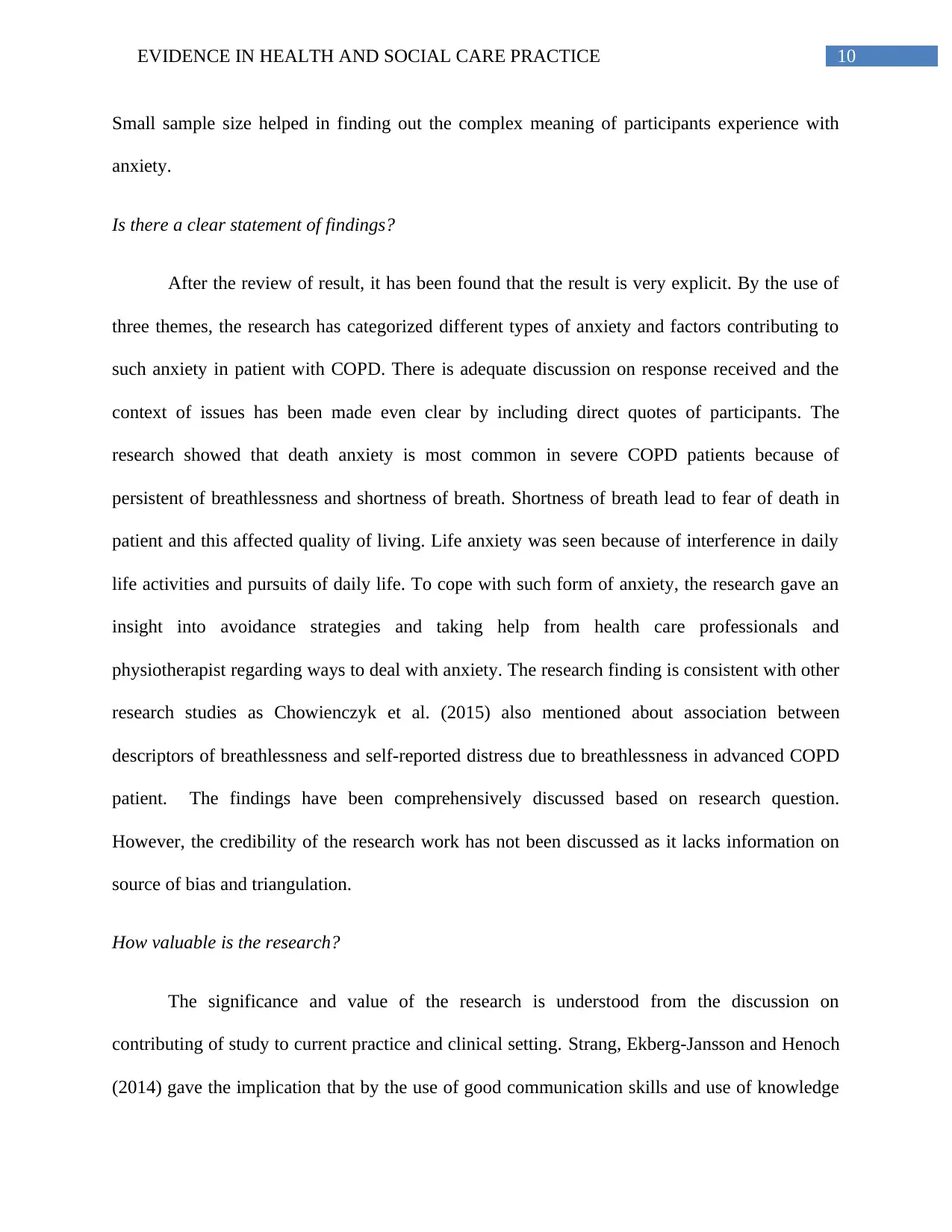
10EVIDENCE IN HEALTH AND SOCIAL CARE PRACTICE
Small sample size helped in finding out the complex meaning of participants experience with
anxiety.
Is there a clear statement of findings?
After the review of result, it has been found that the result is very explicit. By the use of
three themes, the research has categorized different types of anxiety and factors contributing to
such anxiety in patient with COPD. There is adequate discussion on response received and the
context of issues has been made even clear by including direct quotes of participants. The
research showed that death anxiety is most common in severe COPD patients because of
persistent of breathlessness and shortness of breath. Shortness of breath lead to fear of death in
patient and this affected quality of living. Life anxiety was seen because of interference in daily
life activities and pursuits of daily life. To cope with such form of anxiety, the research gave an
insight into avoidance strategies and taking help from health care professionals and
physiotherapist regarding ways to deal with anxiety. The research finding is consistent with other
research studies as Chowienczyk et al. (2015) also mentioned about association between
descriptors of breathlessness and self-reported distress due to breathlessness in advanced COPD
patient. The findings have been comprehensively discussed based on research question.
However, the credibility of the research work has not been discussed as it lacks information on
source of bias and triangulation.
How valuable is the research?
The significance and value of the research is understood from the discussion on
contributing of study to current practice and clinical setting. Strang, Ekberg-Jansson and Henoch
(2014) gave the implication that by the use of good communication skills and use of knowledge
Small sample size helped in finding out the complex meaning of participants experience with
anxiety.
Is there a clear statement of findings?
After the review of result, it has been found that the result is very explicit. By the use of
three themes, the research has categorized different types of anxiety and factors contributing to
such anxiety in patient with COPD. There is adequate discussion on response received and the
context of issues has been made even clear by including direct quotes of participants. The
research showed that death anxiety is most common in severe COPD patients because of
persistent of breathlessness and shortness of breath. Shortness of breath lead to fear of death in
patient and this affected quality of living. Life anxiety was seen because of interference in daily
life activities and pursuits of daily life. To cope with such form of anxiety, the research gave an
insight into avoidance strategies and taking help from health care professionals and
physiotherapist regarding ways to deal with anxiety. The research finding is consistent with other
research studies as Chowienczyk et al. (2015) also mentioned about association between
descriptors of breathlessness and self-reported distress due to breathlessness in advanced COPD
patient. The findings have been comprehensively discussed based on research question.
However, the credibility of the research work has not been discussed as it lacks information on
source of bias and triangulation.
How valuable is the research?
The significance and value of the research is understood from the discussion on
contributing of study to current practice and clinical setting. Strang, Ekberg-Jansson and Henoch
(2014) gave the implication that by the use of good communication skills and use of knowledge
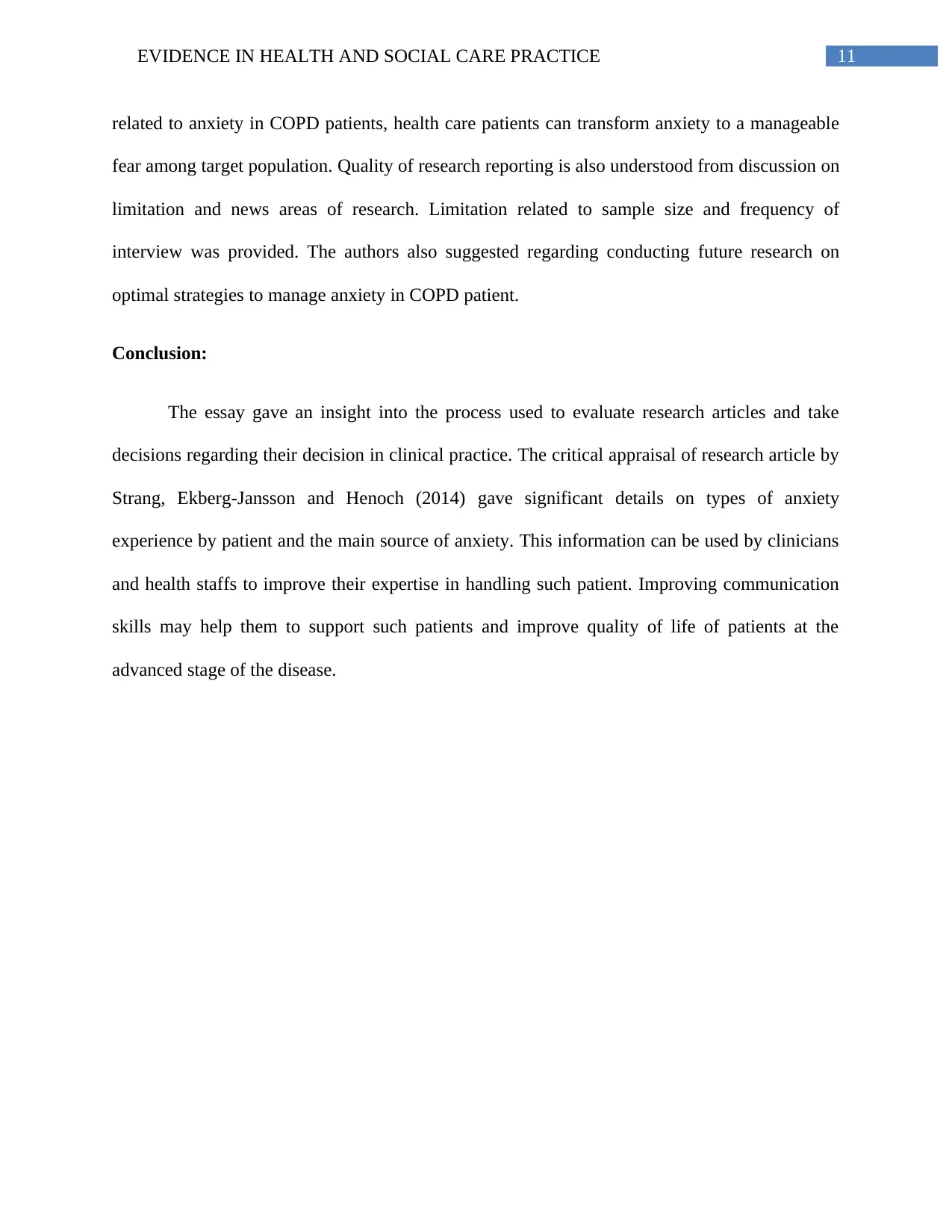
11EVIDENCE IN HEALTH AND SOCIAL CARE PRACTICE
related to anxiety in COPD patients, health care patients can transform anxiety to a manageable
fear among target population. Quality of research reporting is also understood from discussion on
limitation and news areas of research. Limitation related to sample size and frequency of
interview was provided. The authors also suggested regarding conducting future research on
optimal strategies to manage anxiety in COPD patient.
Conclusion:
The essay gave an insight into the process used to evaluate research articles and take
decisions regarding their decision in clinical practice. The critical appraisal of research article by
Strang, Ekberg-Jansson and Henoch (2014) gave significant details on types of anxiety
experience by patient and the main source of anxiety. This information can be used by clinicians
and health staffs to improve their expertise in handling such patient. Improving communication
skills may help them to support such patients and improve quality of life of patients at the
advanced stage of the disease.
related to anxiety in COPD patients, health care patients can transform anxiety to a manageable
fear among target population. Quality of research reporting is also understood from discussion on
limitation and news areas of research. Limitation related to sample size and frequency of
interview was provided. The authors also suggested regarding conducting future research on
optimal strategies to manage anxiety in COPD patient.
Conclusion:
The essay gave an insight into the process used to evaluate research articles and take
decisions regarding their decision in clinical practice. The critical appraisal of research article by
Strang, Ekberg-Jansson and Henoch (2014) gave significant details on types of anxiety
experience by patient and the main source of anxiety. This information can be used by clinicians
and health staffs to improve their expertise in handling such patient. Improving communication
skills may help them to support such patients and improve quality of life of patients at the
advanced stage of the disease.
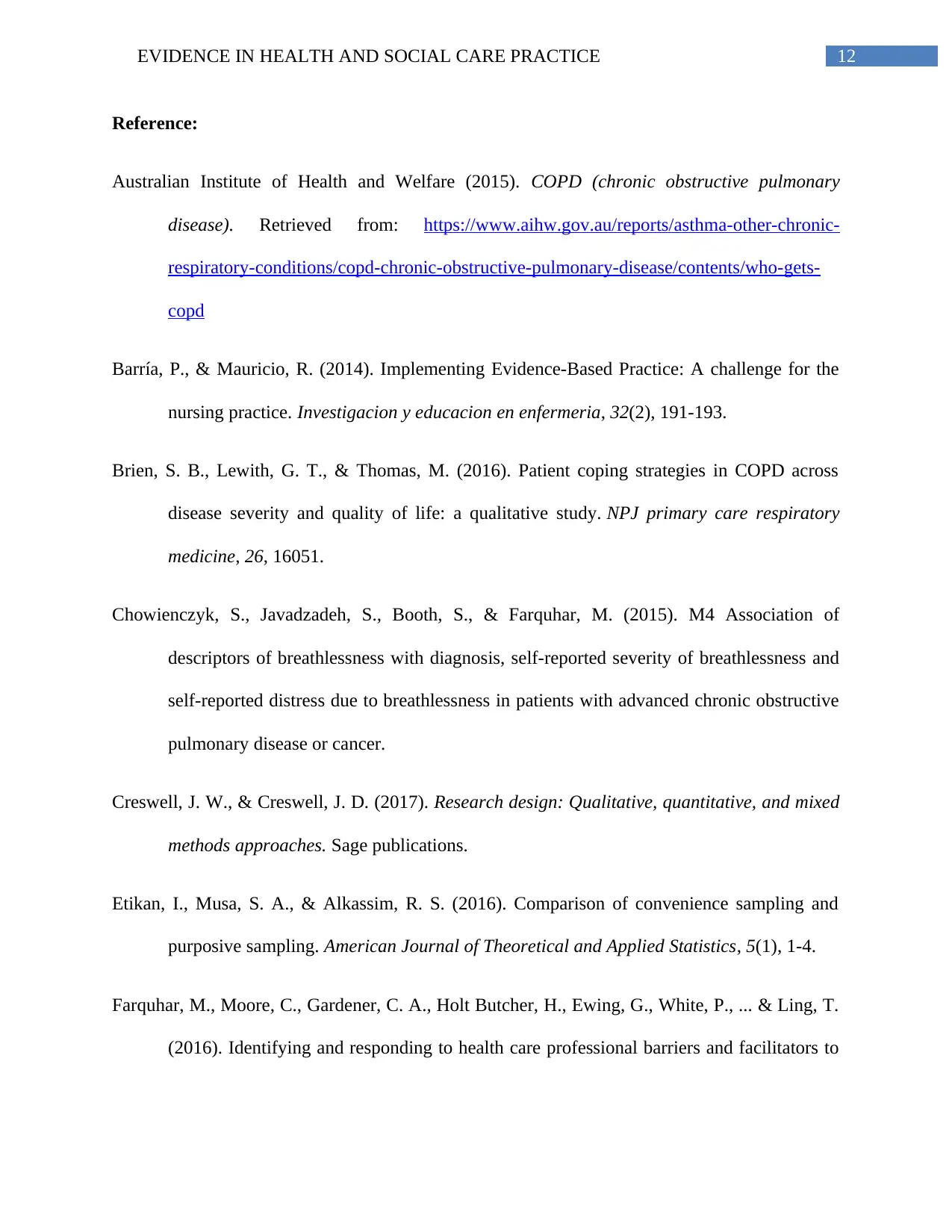
12EVIDENCE IN HEALTH AND SOCIAL CARE PRACTICE
Reference:
Australian Institute of Health and Welfare (2015). COPD (chronic obstructive pulmonary
disease). Retrieved from: https://www.aihw.gov.au/reports/asthma-other-chronic-
respiratory-conditions/copd-chronic-obstructive-pulmonary-disease/contents/who-gets-
copd
Barría, P., & Mauricio, R. (2014). Implementing Evidence-Based Practice: A challenge for the
nursing practice. Investigacion y educacion en enfermeria, 32(2), 191-193.
Brien, S. B., Lewith, G. T., & Thomas, M. (2016). Patient coping strategies in COPD across
disease severity and quality of life: a qualitative study. NPJ primary care respiratory
medicine, 26, 16051.
Chowienczyk, S., Javadzadeh, S., Booth, S., & Farquhar, M. (2015). M4 Association of
descriptors of breathlessness with diagnosis, self-reported severity of breathlessness and
self-reported distress due to breathlessness in patients with advanced chronic obstructive
pulmonary disease or cancer.
Creswell, J. W., & Creswell, J. D. (2017). Research design: Qualitative, quantitative, and mixed
methods approaches. Sage publications.
Etikan, I., Musa, S. A., & Alkassim, R. S. (2016). Comparison of convenience sampling and
purposive sampling. American Journal of Theoretical and Applied Statistics, 5(1), 1-4.
Farquhar, M., Moore, C., Gardener, C. A., Holt Butcher, H., Ewing, G., White, P., ... & Ling, T.
(2016). Identifying and responding to health care professional barriers and facilitators to
Reference:
Australian Institute of Health and Welfare (2015). COPD (chronic obstructive pulmonary
disease). Retrieved from: https://www.aihw.gov.au/reports/asthma-other-chronic-
respiratory-conditions/copd-chronic-obstructive-pulmonary-disease/contents/who-gets-
copd
Barría, P., & Mauricio, R. (2014). Implementing Evidence-Based Practice: A challenge for the
nursing practice. Investigacion y educacion en enfermeria, 32(2), 191-193.
Brien, S. B., Lewith, G. T., & Thomas, M. (2016). Patient coping strategies in COPD across
disease severity and quality of life: a qualitative study. NPJ primary care respiratory
medicine, 26, 16051.
Chowienczyk, S., Javadzadeh, S., Booth, S., & Farquhar, M. (2015). M4 Association of
descriptors of breathlessness with diagnosis, self-reported severity of breathlessness and
self-reported distress due to breathlessness in patients with advanced chronic obstructive
pulmonary disease or cancer.
Creswell, J. W., & Creswell, J. D. (2017). Research design: Qualitative, quantitative, and mixed
methods approaches. Sage publications.
Etikan, I., Musa, S. A., & Alkassim, R. S. (2016). Comparison of convenience sampling and
purposive sampling. American Journal of Theoretical and Applied Statistics, 5(1), 1-4.
Farquhar, M., Moore, C., Gardener, C. A., Holt Butcher, H., Ewing, G., White, P., ... & Ling, T.
(2016). Identifying and responding to health care professional barriers and facilitators to
Paraphrase This Document
Need a fresh take? Get an instant paraphrase of this document with our AI Paraphraser
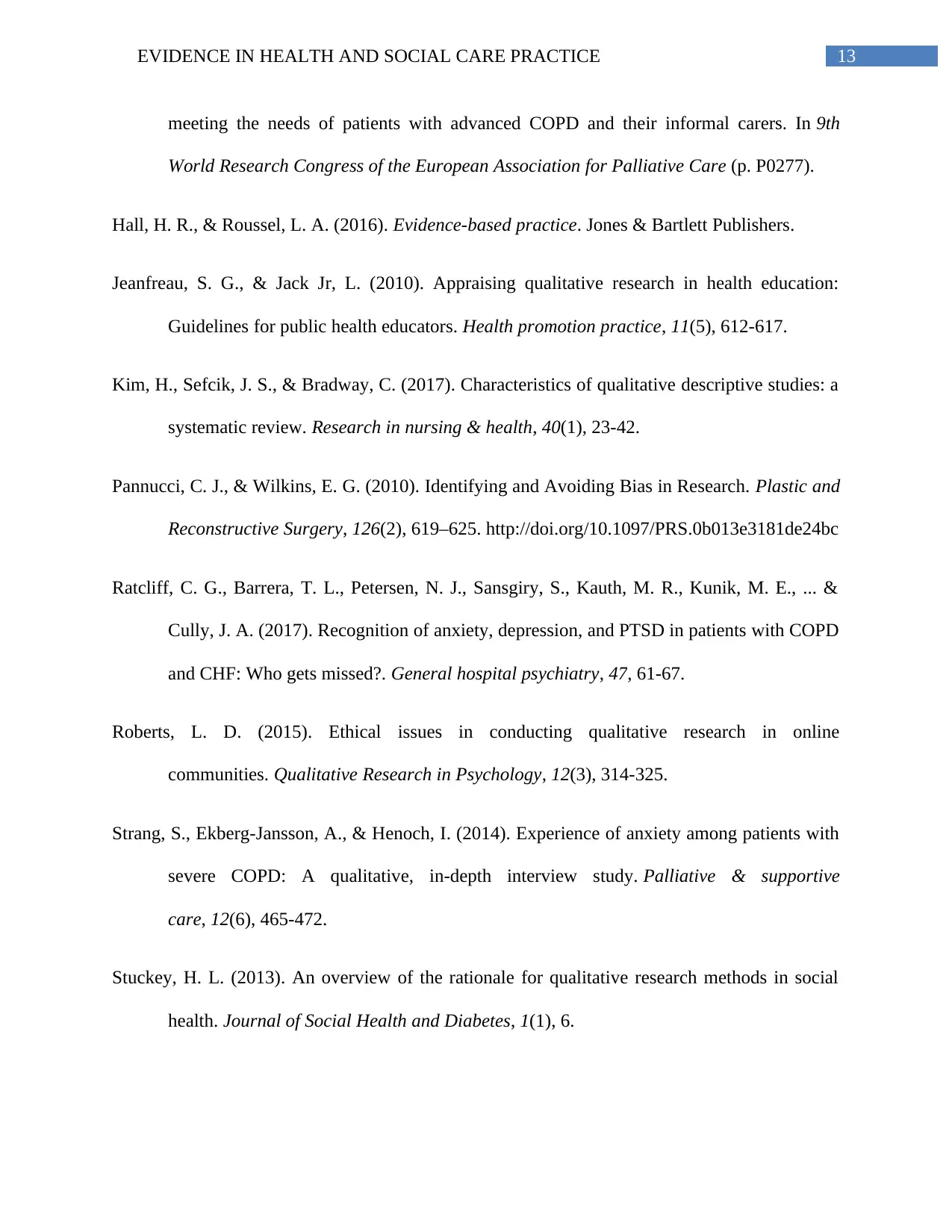
13EVIDENCE IN HEALTH AND SOCIAL CARE PRACTICE
meeting the needs of patients with advanced COPD and their informal carers. In 9th
World Research Congress of the European Association for Palliative Care (p. P0277).
Hall, H. R., & Roussel, L. A. (2016). Evidence-based practice. Jones & Bartlett Publishers.
Jeanfreau, S. G., & Jack Jr, L. (2010). Appraising qualitative research in health education:
Guidelines for public health educators. Health promotion practice, 11(5), 612-617.
Kim, H., Sefcik, J. S., & Bradway, C. (2017). Characteristics of qualitative descriptive studies: a
systematic review. Research in nursing & health, 40(1), 23-42.
Pannucci, C. J., & Wilkins, E. G. (2010). Identifying and Avoiding Bias in Research. Plastic and
Reconstructive Surgery, 126(2), 619–625. http://doi.org/10.1097/PRS.0b013e3181de24bc
Ratcliff, C. G., Barrera, T. L., Petersen, N. J., Sansgiry, S., Kauth, M. R., Kunik, M. E., ... &
Cully, J. A. (2017). Recognition of anxiety, depression, and PTSD in patients with COPD
and CHF: Who gets missed?. General hospital psychiatry, 47, 61-67.
Roberts, L. D. (2015). Ethical issues in conducting qualitative research in online
communities. Qualitative Research in Psychology, 12(3), 314-325.
Strang, S., Ekberg-Jansson, A., & Henoch, I. (2014). Experience of anxiety among patients with
severe COPD: A qualitative, in-depth interview study. Palliative & supportive
care, 12(6), 465-472.
Stuckey, H. L. (2013). An overview of the rationale for qualitative research methods in social
health. Journal of Social Health and Diabetes, 1(1), 6.
meeting the needs of patients with advanced COPD and their informal carers. In 9th
World Research Congress of the European Association for Palliative Care (p. P0277).
Hall, H. R., & Roussel, L. A. (2016). Evidence-based practice. Jones & Bartlett Publishers.
Jeanfreau, S. G., & Jack Jr, L. (2010). Appraising qualitative research in health education:
Guidelines for public health educators. Health promotion practice, 11(5), 612-617.
Kim, H., Sefcik, J. S., & Bradway, C. (2017). Characteristics of qualitative descriptive studies: a
systematic review. Research in nursing & health, 40(1), 23-42.
Pannucci, C. J., & Wilkins, E. G. (2010). Identifying and Avoiding Bias in Research. Plastic and
Reconstructive Surgery, 126(2), 619–625. http://doi.org/10.1097/PRS.0b013e3181de24bc
Ratcliff, C. G., Barrera, T. L., Petersen, N. J., Sansgiry, S., Kauth, M. R., Kunik, M. E., ... &
Cully, J. A. (2017). Recognition of anxiety, depression, and PTSD in patients with COPD
and CHF: Who gets missed?. General hospital psychiatry, 47, 61-67.
Roberts, L. D. (2015). Ethical issues in conducting qualitative research in online
communities. Qualitative Research in Psychology, 12(3), 314-325.
Strang, S., Ekberg-Jansson, A., & Henoch, I. (2014). Experience of anxiety among patients with
severe COPD: A qualitative, in-depth interview study. Palliative & supportive
care, 12(6), 465-472.
Stuckey, H. L. (2013). An overview of the rationale for qualitative research methods in social
health. Journal of Social Health and Diabetes, 1(1), 6.

14EVIDENCE IN HEALTH AND SOCIAL CARE PRACTICE
Thakur, E. R., Sansgiry, S., Petersen, N. J., Stanley, M., Kunik, M. E., Naik, A. D., & Cully, J.
A. (2018). Cognitive and perceptual factors, not disease severity, are linked with anxiety
in COPD: results from a cross-sectional study. International journal of behavioral
medicine, 25(1), 74-84.
World Health Organization (2016). Chronic obstructive pulmonary disease (COPD). Retrieved
from: http://www.who.int/news-room/fact-sheets/detail/chronic-obstructive-pulmonary-
disease-(copd)
Yohannes, A. M., & Alexopoulos, G. S. (2014). Depression and anxiety in patients with
COPD. European Respiratory Review, 23(133), 345-349.
Zeng, X., Zhang, Y., Kwong, J. S., Zhang, C., Li, S., Sun, F., ... & Du, L. (2015). The
methodological quality assessment tools for preclinical and clinical studies, systematic
review and meta‐analysis, and clinical practice guideline: a systematic review. Journal of
evidence-based medicine, 8(1), 2-10.
Thakur, E. R., Sansgiry, S., Petersen, N. J., Stanley, M., Kunik, M. E., Naik, A. D., & Cully, J.
A. (2018). Cognitive and perceptual factors, not disease severity, are linked with anxiety
in COPD: results from a cross-sectional study. International journal of behavioral
medicine, 25(1), 74-84.
World Health Organization (2016). Chronic obstructive pulmonary disease (COPD). Retrieved
from: http://www.who.int/news-room/fact-sheets/detail/chronic-obstructive-pulmonary-
disease-(copd)
Yohannes, A. M., & Alexopoulos, G. S. (2014). Depression and anxiety in patients with
COPD. European Respiratory Review, 23(133), 345-349.
Zeng, X., Zhang, Y., Kwong, J. S., Zhang, C., Li, S., Sun, F., ... & Du, L. (2015). The
methodological quality assessment tools for preclinical and clinical studies, systematic
review and meta‐analysis, and clinical practice guideline: a systematic review. Journal of
evidence-based medicine, 8(1), 2-10.
1 out of 15
Related Documents
Your All-in-One AI-Powered Toolkit for Academic Success.
+13062052269
info@desklib.com
Available 24*7 on WhatsApp / Email
![[object Object]](/_next/static/media/star-bottom.7253800d.svg)
Unlock your academic potential
© 2024 | Zucol Services PVT LTD | All rights reserved.





